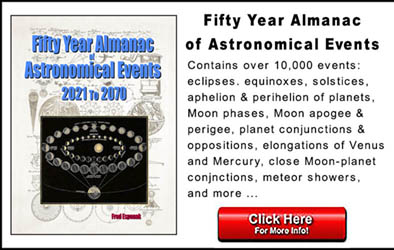Eclipses During 2018
By Fred Espenak
Based on the Article Published in
Observer's Handbook
2018
,
Royal Astronomical Society of Canada
In 2018, there are three partial solar eclipses and two total lunar eclipses:
| Eclipses During 2018 | |||
| 2018 Jan 31: Total Lunar Eclipse | |||
| 2018 Feb 15: Partial Solar Eclipse | |||
| 2018 Jul 13: Partial Solar Eclipse | |||
| 2018 Jul 27: Total Lunar Eclipse | |||
| 2018 Aug 11: Partial Solar Eclipse | |||
| Eclipses During 2018 | ||||
|
Total Lunar Eclipse 2018 Jan 31 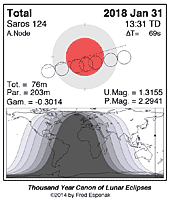
|
Partial Solar Eclipse 2018 Feb 15 
|
Partial Solar Eclipse 2018 Jul 13 
|
Total Lunar Eclipse 2018 Jul 27 
|
Partial Solar Eclipse 2018 Aug 11 
|
Predictions for the eclipses are summarized in Figures 1, 2, 3, 4, and 5. World maps show the regions of visibility for each eclipse. The lunar eclipse diagrams also include the path of the Moon through Earth's shadow. Contact times for each principal phase are tabulated along with the magnitudes and geocentric coordinates of the Sun and Moon at greatest eclipse.
Unless otherwise stated, all times and dates used in this publication are in Universal Time or UT. This astronomically derived time system is colloquially referred to as Greenwich Mean Time or GMT. To learn more about UT and how to convert UT to your own local time, see Time Zones and Universal Time.

Click for larger more detailed figure
Total Lunar Eclipse of 2018 Jan 31
The first lunar eclipse of the year occurs at the lunar orbit's ascending node in Cancer. The apparent diameter of the Moon is larger than average since the eclipse occurs 1.2 days after perigee (Jan 30 at 09:54 UT). This is the first of three consecutive total lunar eclipses in 2018 and 2019, each one separated by six months.
The Moon's orbital trajectory takes it through the southern half of Earth's umbral shadow. In this particular case, the Moon passes deeply into the umbral shadow leading to a relatively long total eclipse lasting 1 hour 16 minutes.
The Moon's path through Earth's shadow as well as a map illustrating worldwide visibility of the event are shown in Figure 1.
The times of the major eclipse phases are as follows.
Penumbral Eclipse Begins: 10:51:13 UT1
Partial Eclipse Begins: 11:48:28 UT1
Total Eclipse Begins: 12:51:49 UT1
Greatest Eclipse: 13:29:51 UT1
Total Eclipse Ends: 14:07:53 UT1
Partial Eclipse Ends: 15:11:14 UT1
Penumbral Eclipse Ends: 16:08:32 UT1
At the instant of greatest eclipse [1] (13:29:51 UT1 [2]) the Moon lies at the zenith for a point in the South Pacific about 1800 miles (2900 km) west of the Hawaiian Islands. The umbral eclipse magnitude [3] peaks at 1.3155 as the Moon's northern limb passes 1.8 arc-minutes south of the umbra's central axis.
In contrast, the Moon's southern limb lies 10.5 arc-minutes from the edge of the shadow. As a result, the northern half of the Moon will appear much darker than the southern half because the Moon samples a large range of umbral depths during the total phase. The exact brightness distribution in the umbra is difficult to predict, so observers are encouraged to estimate the Danjon value at mid-totality (see Danjon Scale of Lunar Eclipse Brightness). It may also be necessary to assign different Danjon values to different portions of the Moon (e.g., north vs. south).
During totality, the winter/spring constellations are well placed for viewing so a number of bright stars can be used for magnitude comparisons. Procyon (m = +0.40) is 21° to the southwest of the eclipsed Moon, while Pollux (m = +1.40) and Castor (m = +1.58) are 19° and 23°, respectively, northwest, and Regulus (m = +1.40) is 19° southeast.
The entire event is visible from the western Pacific Ocean, Alaska, western Canada, Hawaii, Australia, New Zealand, Indonesia, the Philippines, China, Japan and eastern Siberia. Much of the eclipse will be seen from North America, but eastern observers will miss the later stages of the eclipse because they occur after moonset. Likewise parts of Eastern Europe and central Asia experience moonrise after the eclipse begins. None of the eclipse is visible from Western Europe or Africa, nor most of South America.
Table 1 lists predicted umbral immersion and emersion times for 25 well-defined lunar craters. The timing of craters is useful in determining the atmospheric enlargement of Earth's shadow (see Crater Timings During Lunar Eclipses).
The January 31 eclipse is the 49th eclipse of Saros [4] 124. This series began on 1152 Aug 17 and is composed of 73 lunar eclipses in the following sequence: 20 penumbral, 8 partial, 28 total, 8 partial, and 9 penumbral eclipses (Espenak and Meeus, 2009a). In this context, the January 31 eclipse is the 21st total eclipse in the series. The last total eclipse is on 2144 Apr 18 and the final eclipse of the series is on 2450 Oct 21.
Complete details for this Saros series can be found at: Saros 124 .
For more information about this eclipse, see the EclipseWise Prime Page on the Total Lunar Eclipse of 2018 January 31.
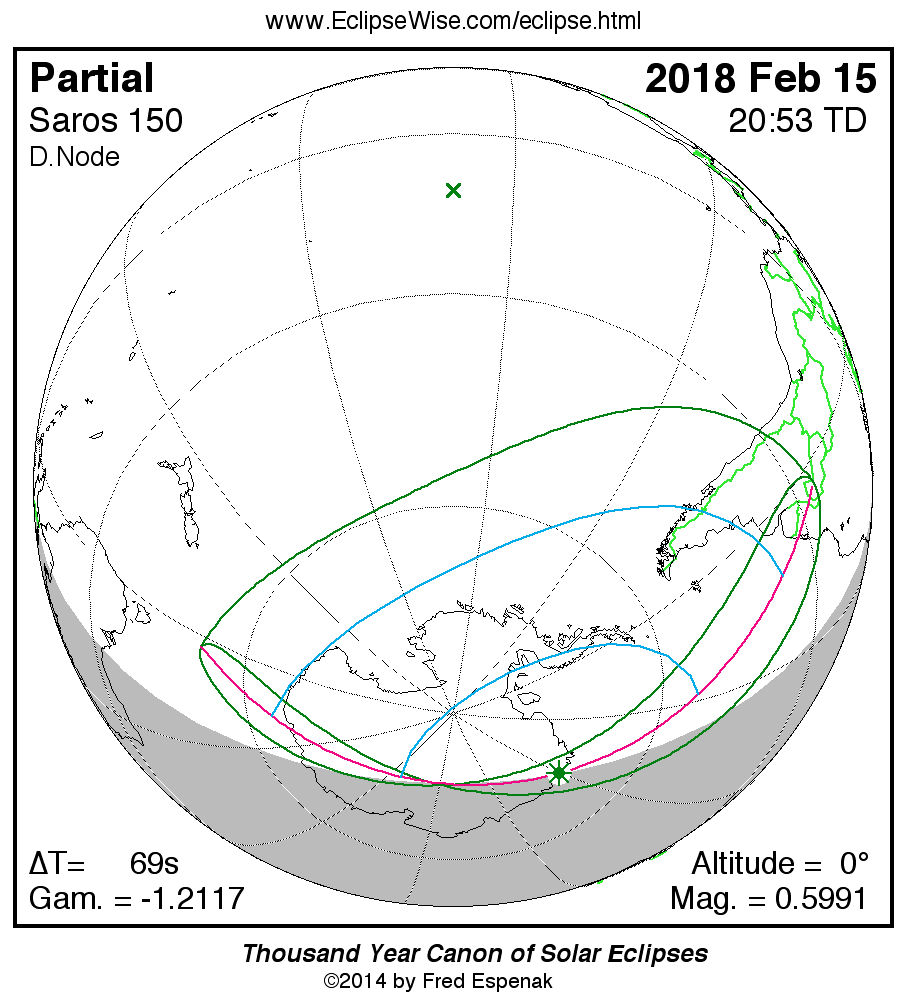
Click for larger more detailed figure
Partial Solar Eclipse of 2018 Feb 15
The first solar eclipse of 2018 occurs in Capricornus at the Moon's descending node. This Southern Hemisphere event is visible from a wedge-shaped region in the Antarctic Ocean that includes 2/3 of Antarctica and southern South America (Figure 2). At greatest eclipse [5] (20:51:24 UT1), the eclipse magnitude [6] is 0.5991.
Local circumstances and eclipse times for a number of cities in South America are listed in Table 2. The Sun's altitude and azimuth, the eclipse magnitude and eclipse obscuration are all given at the instant of maximum eclipse. When the eclipse is in progress at sunset, this information is indicated by '– s'. The 2018 Feb 15 Solar Eclipse Circumstances Calculator is an interactive web page that can quickly calculate the local circumstances for the eclipse from any geographic location not included in Table 2.
This event is the 17th eclipse of Saros 150. The family will produce 22 partial eclipses, followed by 40 annular eclipses and ending with 9 more partials. The entire series of 69 eclipses spans the years 1729 through 2991. Complete details for the series can be found at: Saros 150 .
For additional details on this event, see the EclipseWise Prime Page on the Partial Solar Eclipse of 2018 Feb 15.
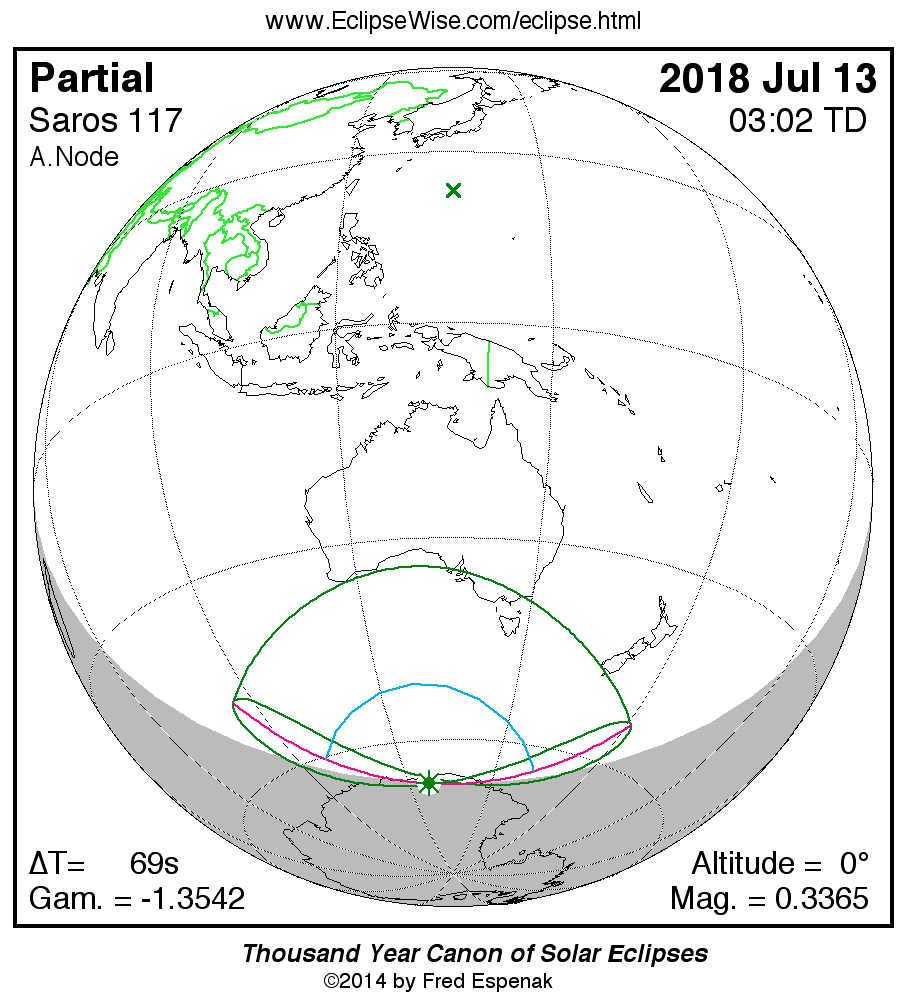
Click for larger more detailed figure
Partial Solar Eclipse of 2018 Jul 13
The next solar eclipse of 2018 occurs in Gemini at the Moon's ascending node. It is also a Southern Hemisphere event and is visible from southeastern Australia and Antarctic Ocean (Figure 3). At greatest eclipse (20:51:24 UT1), the eclipse magnitude is 0.5991.
Local circumstances and eclipse times for a number of cities in Australia appear in Table 3. The Sun's altitude and azimuth, the eclipse magnitude and eclipse obscuration are all given at the instant of maximum eclipse. This is a very minor eclipse from Australia with eclipse magnitudes no greater than 0.10. The 2018 Jul 13 Solar Eclipse Circumstances Calculator is an interactive web page that can quickly calculate the local circumstances for the eclipse from any geographic location not included in Table 3.
This event is the 69th eclipse of Saros 117. The entire series of 71 eclipses spans the years 0792 through 2054. Complete details for the series can be found at: Saros 117 .
For additional details on this event, see the EclipseWise Prime Page on the Partial Solar Eclipse of 2018 Jul 13.

Click for larger more detailed figure
Total Lunar Eclipse of 2018 Jul 27
The second total lunar eclipse of 2018 occurs at the Moon's descending node in Capricornus. It takes place just 0.6 days after the Moon reaches apogee (Jul 27 05:44 UT1) so the Moon's apparent size (14' 43”) is near its minimum.
This total lunar eclipse is even deeper than the first one with the Moon passing through the middle of the umbral shadow. At greatest eclipse, the center of the Moon passes 6.3 arc-minutes from the axis of the shadow. This corresponds to an umbral eclipse magnitude[8] of 1.6087. Depending on the transparency of Earth's atmosphere, this could be a very dark eclipse
The Moon's path through Earth's shadow as well as a map illustrating worldwide visibility of the event are shown in Figure 4.
The times of the major eclipse phases are as follows.
Penumbral Eclipse Begins: 17:14:48 UT1
Partial Eclipse Begins: 18:24:28 UT1
Total Eclipse Begins: 19:30:17 UT1
Greatest Eclipse: 20:21:45 UT1
Total Eclipse Ends: 21:13:14 UT1
Partial Eclipse Ends: 22:19:03 UT1
Penumbral Eclipse Ends: 23:28:42 UT1
At the instant of greatest eclipse (20:21:45 UT1) the Moon lies near the zenith from a location in the Indian Ocean just east of Madagascar. The event is well placed for observers in Europe, Africa, Asia, and Australia. None of the eclipse will be visible from North America. South America will see some of the late stages of the eclipse as the Moon rises.
Table 4 lists predicted umbral immersion and emersion times for 25 well-defined lunar craters. The timing of craters is useful in determining the atmospheric enlargement of Earth's shadow (see Crater Timings During Lunar Eclipses).
The July 27 eclipse is the 38th eclipse of Saros 129. This series began on 1351 Jun 10 and is composed of 71 lunar eclipses in the following sequence: 10 penumbral, 21 partial, 11 total, 21 partial, and 8 penumbral eclipses (Espenak and Meeus, 2009a). The last total eclipse is on 2090 Sep 08 and the final eclipse of the series is on 2613 Jul 24.
Complete details for the series can be found at: Saros 129.
For additional details on this event, see the EclipseWise Prime Page on the Total Lunar Eclipse of 2018 Jul 27.
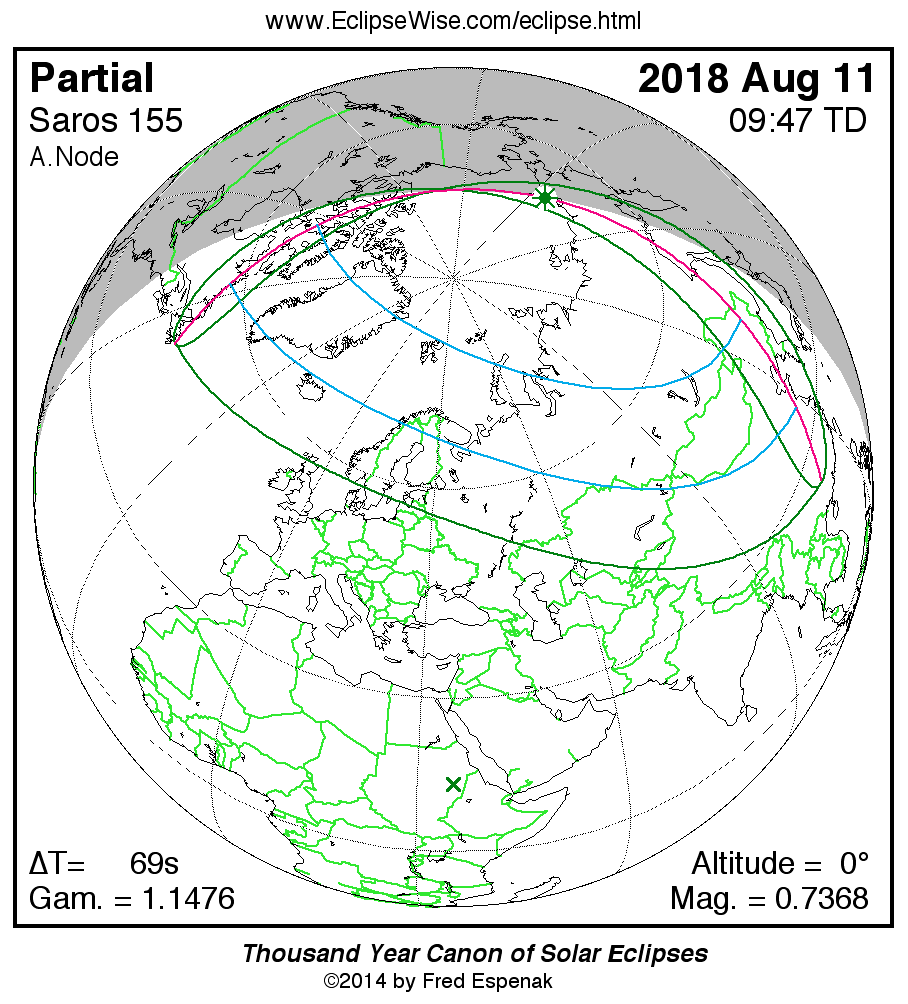
Click for larger more detailed figure
Partial Solar Eclipse of 2018 Aug 11
The last eclipse of the year is the third partial solar eclipse. It occurs in Leo at the Moon's ascending node. This time the event is visible from the Northern Hemisphere and includes northeastern Canada, Greenland, Iceland, Northern Europe, north and eastern Asia. (Figure 5). At greatest eclipse (09:46:19 UT1), the magnitude is 0.7368.
Local circumstances and eclipse times for a number of cities in Europe and Asia are listed in Table 5. The Sun's altitude and azimuth, the eclipse magnitude and eclipse obscuration are all given at the instant of maximum eclipse. When the eclipse is in progress at sunset, this information is indicated by '– s'. The 2018 Aug 11 Solar Eclipse Circumstances Calculator is an interactive web page that can quickly calculate the local circumstances for the eclipse from any geographic location not included in Table 5.
This eclipse belongs to Saros 155 and is number 6 of 71 eclipses in the series. All eclipses in the series occur at the Moon's ascending node. The Moon moves southward with respect to the node with each succeeding eclipse in the series and gamma[9] decreases.
For additional details on this event, see the EclipseWise Prime Page on the Partial Solar Eclipse of 2018 Aug 11.
Explanatory Information
Solar Eclipse Figures
Lunar Eclipse Figures
Shadow Diameters and Lunar Eclipses
Danjon Scale of Lunar Eclipse Brightness
Crater Timings During Lunar Eclipses
Eclipse Altitudes and Azimuths
The altitude a and azimuth A of the Sun or Moon during an eclipse depend on the time and the observer's geographic coordinates. They are calculated as follows:
h = 15 (GST + UT - α ) + λ
a = arcsin [sin δ sin φ + cos δ cos h cos φ]
A = arctan [-(cos δ sin h)/(sin δ cos φ - cos δ cos h sin φ)]
where
h = hour angle of Sun or Moon
a = altitude
A = azimuth
GST = Greenwich Sidereal Time at 0:00 UT
UT = Universal Time
α = right ascension of Sun or Moon
δ = declination of Sun or Moon
λ = observer's longitude (east +, west -)
φ = observer's latitude (north +, south -)
During the eclipses of 2018, the values for GST and the geocentric Right Ascension and Declination of the Sun or the Moon (at greatest eclipse) are as follows:
Eclipse Date GST α δ
Total Lunar 2018 Jan 31 8.715 8.935 16.996
Partial Solar 2018 Feb 15 9.721 21.955 -12.469
Partial Solar 2018 Jul 13 19.397 7.492 21.842
Total Lunar 2018 Jul 27 20.364 20.472 -18.970
Partial Solar 2018 Aug 11 21.321 9.408 15.222
Two web based tools that can also be used to calculate the local circumstances for all solar and lunar eclipses visible from any location. They are the Javascript Solar Eclipse Explorer and the Javascript Lunar Eclipse Explorer. The URLs for these tools are:
Javascript Solar Eclipse Explorer: www.EclipseWise.com/solar/JSEX/JSEX-index.html
Javascript Lunar Eclipse Explorer: www.EclipseWise.com/lunar/JLEX/JLEX-index.html
Eclipses During 2019
In 2019, there are three solar eclipses and two lunar eclipses:
| Eclipses During 2019 | |||
| 2019 Jan 06: Partial Solar Eclipse | |||
| 2019 Jan 21: Total Lunar Eclipse | |||
| 2019 Jul 02: Total Solar Eclipse | |||
| 2019 Jul 16: Partial Lunar Eclipse | |||
| 2019 Dec 26: Annular Solar Eclipse | |||
| Eclipses During 2019 | ||||
|
Partial Solar Eclipse 2019 Jan 06 
|
Total Lunar Eclipse 2019 Jan 21 
|
Total Solar Eclipse 2019 Jul 02 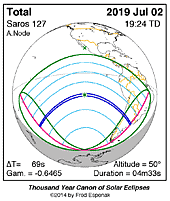
|
Partial Lunar Eclipse 2019 Jul 16 
|
Annular Solar Eclipse 2019 Dec 26 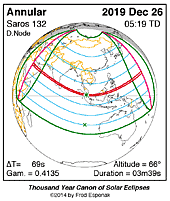
|
A full report Eclipses During 2019 will be published in Observer's Handbook:2019
Eclipse Web Sites
EclipseWise.com is a website dedicated to predictions and information on eclipses of the Sun and Moon. It offers a graphically intuitive interface and contains maps, diagrams, tables, and information about every solar and lunar eclipse from 2000 BCE to 3000 CE. This period includes 11898 solar eclipses and 12064 lunar eclipses.
Much of EclipseWise.com is based on the Thousand Year Canon of Solar Eclipses 1501 to 2500 (Espenak 2014a) and the Thousand Year Canon of Lunar Eclipses 1501 to 2500 (Espenak 2014b). These eclipse predictions use the Jet Propulsion Lab's DE406 — a computer ephemeris used for calculating high precision coordinates of the Sun and Moon for thousands of years into the past and future.
For eclipses over a larger time interval see Five Millennium Canon of Solar Eclipses –1999 to +3000 and Five Millennium Canon of Lunar Eclipses –-1999 to +3000.
The World Atlas of Solar Eclipses provides maps of all central eclipse paths from 2000 BCE to 3000 CE.
MrEclipse.com targets solar and lunar eclipse photography, with tips on eclipse observing and eye safety.
For web versions of this article for other years, visit the following:Acknowledgments
All eclipse predictions were generated on a Macintosh G4 PowerPC using algorithms developed from the Explanatory Supplement [1974] with additional algorithms from Meeus, Grosjean, and Vanderleen [1966]. The solar and lunar coordinates used in the eclipse predictions are based on the JPL DE405. For lunar eclipses, the diameter of the umbral and penumbral shadows were calculated using Danjon's rule of enlarging Earth's radius by 1/85 to compensate for the opacity of the terrestrial atmosphere; corrections for the mean effects of oblateness have also been included.
All calculations, diagrams, tables, and opinions presented in this paper are those of the author, and he assumes full responsibility for their accuracy.
Permission is granted to reproduce the eclipse data when accompanied by a link to this page and an acknowledgment:
"Eclipse Predictions by Fred Espenak, EclipseWise.com"
The use of diagrams and maps is permitted provided that they are unaltered (except for re-sizing) and the embedded credit line is not removed or concealed.
Footnotes
[1] The instant of greatest eclipse for lunar eclipses occurs when the distance between the Moon's shadow axis and Earth's geocenter reaches a minimum.
[2] UT1 or Universal Time is the mean solar time on the Prime Meridian at Greenwich, England. Civil time signals are transmitted according to Coordinated Universal Time (UTC), which is based on International Atomic Time (TAI) with leap seconds added at irregular intervals to compensate for the slowing of Earth's rotation. The leap seconds keep UTC within 0.9 second of UT1.
[3] Penumbral eclipse magnitude is defined as the fraction of the Moon's diameter occulted by Earth's penumbral shadow.
[4] The Saros is a period of 6,585.3 days (18 years 11 days 8 hours) in which eclipses (both solar and lunar) repeat. The geometry isn't exact but close enough for a Saros series to last 12 or more centuries.
[5] The instant of greatest eclipse for solar eclipses occurs when the distance between the Moon's shadow axis and Earth's geocenter reaches a minimum.
[6] Eclipse magnitude for solar eclipses is defined as the fraction of the Sun's diameter occulted by the Moon.
[7] Eclipse obscuration is defined as the fraction of the Sun's area occulted by the Moon.
[8] Umbral eclipse magnitude is defined as the fraction of the Moon's diameter occulted by Earth's umbral shadow.
[9] Gamma is the distance of the Moon's shadow axis from Earth's center (in Earth radii) when it reaches its minimum absolute value.
References
Chauvenet, W., Manual of Spherical and Practical Astronomy, Vol.1, 1891 (Dover edition 1961).
Danjon, A., "Les éclipses de Lune par la pénombre en 1951," L'Astronomie, 65, 51-53 (Feb. 1951).
Espenak, F., and Meeus, J., Five Millennium Canon of Solar Eclipses: –1999 to +3000 (2000 BCE to 3000 CE), NASA TP–2006-214141, Goddard Space Flight Center, Greenbelt, MD, 2006.
Espenak, F., and Meeus, J., Five Millennium Canon of Lunar Eclipses: –1999 to +3000 (2000 BCE to 3000 CE), NASA TP–2009-214172, Goddard Space Flight Center, Greenbelt, MD, 2009a.
Espenak, F., and Meeus, J., Five Millennium Catalog of Lunar Eclipses: –1999 to +3000 (2000 BCE to 3000 CE), NASA TP–2009-214173, Goddard Space Flight Center, Greenbelt, MD, 2009b.
Espenak, F., and Meeus, J., Five Millennium Catalog of Solar Eclipses: –1999 to +3000 (2000 BCE to 3000 CE), NASA TP–2009-214174, Goddard Space Flight Center, Greenbelt, MD, 2009c.
Espenak, F., Thousand Year Canon of Solar Eclipses 1501 to 2500, AstroPixels Publishing, Portal, AZ, 2014.
Espenak, F., Thousand Year Canon of Lunar Eclipses 1501 to 2500, AstroPixels Publishing, Portal, AZ, 2014.
Espenak, F., 21st Century Canon of Solar Eclipses, AstroPixels Publishing, Portal, AZ, 2016.
Espenak, F., Atlas of Central Solar Eclipses in the USA, AstroPixels Publishing, Portal, AZ, 2016.
Explanatory Supplement to the Astronomical Ephemeris and the American Ephemeris and Nautical Almanac, Her Majesty's Nautical Almanac Office, London, 1974.




